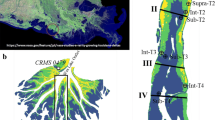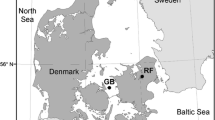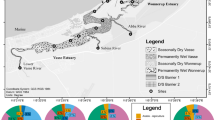Abstract
Climatic variables, water quality, benthic fluxes, sediment properties, and infauna were measured six times over an annual cycle in a shallow sub-tropical embayment to characterize carbon and nutrient cycling, and elucidate the role of pelagic–benthic coupling. Organic carbon (OC) inputs to the bay are dominated by phytoplankton (mean 74%), followed by catchment inputs (15%), and benthic microalgae (BMA; 9%). The importance of catchment inputs was highly variable and dependent on antecedent rainfall, with significant storage of allochthonous OC in sediments following high flow events and remineralization of this material supporting productivity during the subsequent period. Outputs were dominated by benthic mineralization (mean 59% of total inputs), followed by pelagic mineralization (16%), burial (1%), and assimilation in macrofaunal biomass (2%). The net ecosystem metabolism (NEM = production minus respiration) varied between −4 and 33% (mean 9%) of total primary production, whereas the productivity/respiration (p/r) ranged between 0.96 and 1.5 (mean 1.13). Up to 100% of the NEM is potentially removed via the demersal detritivore pathway. Dissolved inorganic nitrogen (DIN) inputs from the catchment contributed less than 1% of the total phytoplankton demand, implicating internal DIN recycling (pelagic 23% and benthic 19%) and potentially benthic dissolved organic nitrogen (DON) fluxes (27%) or N fixation (up to 47%) as important processes sustaining productivity. Although phytoplankton dominated OC inputs in this system, BMA exerted strong seasonal controls over benthic DIN fluxes, limiting pelagic productivity when mixing/photic depth approached 1.3. The results of this study suggest low DIN:TOC and net autotrophic NEM may be a significant feature of shallow sub-tropical systems where the mixing/photic depth is consistently less than 4.





Similar content being viewed by others
References
Abbs D, McInnes K. 2004. The impact of climate change on extreme rainfall and coastal sea levels over south-east Queensland part 1: analysis of extreme rainfall and wind events in a GCM., Report to Gold Coast City Council.
Boynton WR, Kemp WM, Keefe CW. 1982. A comparative analysis of nutrients and other factors influencing estuarine phytoplankton production. New York: Academic Press.
Bronk DA, See JH, Bradley P, Killberg L. 2007. DON as a source of bioavailable nitrogen for phytoplankton. Biogeosciences 4:283–96.
Bulling MT, White PCL, Raffaelli D, Pierce GJ. 2006. Using model systems to address the biodiversity-ecosystem functioning process. Mar Ecol Prog Ser 311:295–309.
Cadee GC, Hegeman J. 1977. Distribution of primary production of the benthic microflora and accumulation of organic matter on a tidal flat area, Balgzand, Dutch Wadden Sea. Neth J Sea Res 11:24–41.
Caffrey JM, Cloern JE, Grenz C. 1998. Changes in production and respiration during a spring phytoplankton bloom in San Francisco Bay, California, USA: implications for net ecosystem metabolism. Mar Ecol Prog Ser 172:1–12.
Camacho-Ibar V, Dupra V, Wulff F, Smith SV, Marshall Crossland JI, Crossland CJ. 2002. Estuarine systems of the Latin American region (Regional Workshop V) and estuarine systems of the Arctic Region: carbon, nitrogen and phosphorus fluxes. Report No. 23. Texel: LOICZ IPO.
Cebrian J. 2002. Variability and control of carbon consumption, export, and accumulation in marine communities. Limnol Oceanogr 47:11–22.
Cloern JE. 2001. Our evolving conceptual model of the coastal eutrophication problem. Mar Ecol Prog Ser 210:223–53.
Cole BE, Cloern JE. 1984. Significance of biomass and light availability to phytoplankton production in San Francisco Bay. Mar Ecol Prog Ser 17:15–24.
Courtney AJ, Tonks ML, Campbell MJ, Roy DP, Gaddes SW, Kyne PM, O’Neill MF. 2006. Quantifying the effects of bycatch reduction devices in Queensland’s (Australia) shallow water eastern king prawn (Penaeus plebejus) trawl fishery. Fish Res 80:136–47.
Dennison WC, Abal EG. 1999. Moreton Bay Study: a scientific basis for the healthy waterways campaign. Brisbane: South East Queensland Regional water Quality Management Strategy.
Descy J-P, Leporcq B, Viroux L, Francois C, Servais P. 2002. Phytoplankton production, exudation and bacterial reassimilation in the River Meuse (Belgium). J Plankton Res 24:161–6.
Eyre B, Twigg C. 1997. Nutrient behaviour during post-flood recovery of the Richmond River Estuary northern NSW, Australia. Estuar Coast Shelf Sci 44:311–26.
Eyre BD. 1995. A first-order nutrient budget for the tropical Moresby estuary and catchment North Queensland, Australia. J Coastal Res 11:717–32.
Eyre BD. 2000. Regional evaluation of nutrient transformation and phytoplankton growth in nine river-dominated sub-tropical east Australian estuaries. Mar Ecol Prog Ser 205:61–83.
Eyre BD, Davies P. 1996. Post-flood (May ‘96) Brisbane River and Estuary Water Quality Monitoring Final Report., Brisbane River and Moreton Bay Wastewater Management Study, Brisbane.
Eyre BD, Ferguson AJP. 2002. Comparison of carbon production and decomposition, benthic nutrient fluxes and denitrification in seagrass, phytoplankton, benthic microalgae- and macroalgae-dominated warm-temperate Australian lagoons. Mar Ecol Prog Ser 229:43–59.
Eyre BD, Ferguson AJP. 2005. Benthic metabolism and nitrogen cycling in a sub-tropical east Australian estuary (Brunswick): temporal variability and controlling factors. Limnol Oceanogr 50(1):81–96.
Eyre BD, Ferguson AJP. 2006. Impact of a flood event on benthic and pelagic coupling in a sub-tropical east Australian estuary (Brunswick). Estuar Coast Shelf Sci 66:111–22.
Eyre BD, Ferguson AJP, Webb A, Maher D, Oaks JM. 2010. Metabolism of different benthic habitats and their contribution to the carbon budget of a shallow oligotrophic sub-tropical coastal system (southern Moreton Bay, Australia). Biogeochemistry. doi:10.1007/s10533-010-9424-7.
Eyre BD, McKee LJ. 2002. Carbon, nitrogen and phosphorus budgets for a shallow sub-tropical coastal embayment (Moreton Bay, Australia). Limnol Oceanogr 47:1043–55.
Eyre BD, Rysgaard S, Dalsgaard T, Christensen PB. 2002. Comparison of isotope pairing and N2/Ar methods for measuring sediment denitrification—assumptions, modifications and implications. Estuaries 25:1077–87.
Ferguson AJP, Eyre BD. 2007. Seasonal discrepancies in denitrification measured by isotope pairing and N2: Ar techniques. Mar Ecol Prog Ser 350:19–27.
Ferguson AJP, Eyre BD. 2010. Interaction of climatic forcing, benthic microalgae and macrofauna in the control of benthic metabolism, nutrient fluxes and denitrification in a shallow sub-tropical coastal embayment (western Moreton Bay, Australia). Biogeochemistry (in press).
Ferguson AJP, Eyre BD, Gay JM. 2003. Organic matter and benthic metabolism in euphotic sediments along shallow sub-tropical estuaries, northern NSW, Australia. Aquat Microb Ecol 33:137–54.
Ferguson AJP, Eyre BD, Gay JM. 2004a. Benthic nutrient fluxes in euphotic sediments along shallow sub-tropical estuaries, northern NSW, Australia. Aquat Microb Ecol 37:219–35.
Ferguson AJP, Eyre BD, Gay JM. 2004b. Nutrient cycling in the sub-tropical Brunswick estuary, Australia. Estuaries 27:1–17.
Ferguson AJP, Eyre BD, Gay JM, Emtage N, Brooks L. 2007. Benthic metabolism and nitrogen cycling in a sub-tropical coastal embayment: spatial and seasonal variation and controlling factors. Aquat Microb Ecol 48:175–95.
Gay JM. 2002. Pelagic and benthic metabolism in three sub-tropical Australian estuaries. PhD, Southern Cross University.
Giblin AE, Hopkinson CS, Tucker J. 1997. Benthic metabolism and nutrient cycling in Boston Harbor, Massachusetts. Estuaries 20:346–64.
Glud RN, Risgaard-Petersen N, Thamdrup B, Fossing H, Rysgaard S. 2000. Benthic carbon mineralisation in a high-Arctic sound (Yound Sound, NE Greenland). Mar Ecol Prog Ser 206:59–71.
Goto N, Kawamura T, Mitamura O, Terai H. 1999. Importance of extracellular organic carbon production in the total primary production by tidal-flat diatoms in comparison to phytoplankton. Mar Ecol Prog Ser 190:289–95.
Gould DM, Gallagher ED 1990. Field measurement of specific growth rate, biomass and primary production of benthic diatoms of Savin Hill Cove, Boston. Limnol Oceanogr 35:1757–70.
Greenwood J et al. 1999. Task plankton trophic dynamics (PTD). Report No. S2R2 No. 17, Brisbane City Council.
Grizzle RE, Penniman CA. 1991. Effects of organic enrichment on estuarine macrofaunal benthos: a comparison of sediment profile imaging and traditional methods. Mar Ecol Prog Ser 74:249–62.
Herman PMJ, Middelburg JJ, van de Koppel J, Heip CHR. 1999. Ecology of estuarine macrobenthos. Adv Ecol Res 29:195–240.
Hopkinson CS, Giblin AE, Tucker J, Garrit RH. 1999. Benthic metabolism and nutrient cycling along an estuarine salinity gradient. Estuaries 22:863–81.
Jeffrey SW, Welschmeyer NA. 1997. Spectrophotometric and fluorometric equations in common use in oceanography. In: Jeffrey SW, Mantoura RFC, Wright SW, Eds. Phytoplankton pigments in oceanography: guidelines to modern methods. Paris: UNESCO. p 597–615.
Jensen LM. 1983. Phytoplankton release of extracellular organic carbon, molecular weight composition, and bacterial assimilation. Mar Ecol Prog Ser 11:39–48.
Jørgensen BB. 1996. Material flux in the sediment. In: Jørgensen BB, Richardson K, Eds. Eutrophication in coastal marine ecosystems, Vol. 52. Washington: American Geophysical Union. p 115–35.
Joiris C, Billen G, Lancelot C, Daro MH, Mommaerts JP, Bertels A, Bossicart M, Hijs J. 1982. A budget of carbon cycling in the Belgian coastal zone: relative roles of zooplankton, bacterioplankton and benthos in the utilization of primary production. Neth J Sea Res 16:260–75.
Kelly JR, Berounsky VM, Nixon SW, Oviatt CA. 1985. Benthic-pelagic coupling and nutrient cycling across an experimental gradient. Mar Ecol Prog Ser 26:207–19.
Kemp WM, Sampou P, Caffrey J, Mayer M. 1990. Ammonium recycling versus denitrification in Cheaspeake Bay sediments. Limnol Oceanogr 35:1545–63.
Kemp WM, Smith EM, Marvin-Dipasquale M, Boynton WR. 1997. Organic carbon balance and net ecosystem metabolism in Chesapeake Bay. Mar Ecol Prog Ser 150:229–48.
Langdon C. 1993. The significance of respiration in production measurements based on oxygen. ICES Mar Sci Symp 197:69–73.
Loneragan N, Bunn SE. 1999. River flows and estuarine ecosystems: implication for coastal fisheries from a review and a case study of the Logan River, southeast Queensland. Aust J Ecol 24:431–40.
Malinsky-Rushansky NZ, Legrand C. 1996. Excretion of dissolved organic carbon by phytoplankton of different sizes and subsequent bacterial uptake. Mar Ecol Prog Ser 132:249–55.
Mallin MA. 1994. Phytoplankton ecology of North Carolina estuaries. Estuaries 17:561–74.
Malone TC, Conley DJ. 1996. Trends in nutrient loading and eutrophication: a comparison of the Chesapeake Bay and the Hudson River estuarine systems. In: Sherman K, Jaworski NA, Smayda TJ, Eds. The Northeast shelf ecosystem: assessment sustainability and management. Cambridge: Blackwell Science. p 327–49.
Marcus NH, Boero F. 1998. Minireview: the importance of benthic-pelagic coupling and the forgotten role of life cycles in coastal aquatic systems. Limnol Oceanogr 43:763–8.
McCarthy M, Pratum T, Hedges J, Benner R. 1997. Chemical composition of dissolved organic nitrogen in the ocean. Nature 390:150–4.
McKee LJ, Eyre BD, Hossain S, Pepperell P. 2001. Impacts of climate geology and humans on spatial and temporal variability in nutrient geochemistry in the sub-tropical Richmond River catchment. Mar Freshwater Res 52:235–48.
Moriarty DJW, Barclay MC. 1981. Carbon and nitrogen content of food and the assimilation efficiencies of penaeid prawns in the Gulf of Carpentaria. Aust J Mar Freshw Res 32:245–51.
Moriarty DJW, Cook HL, bin Hassan R, Thanabal M. 1984. The contribution of primary production and meiofauna to food chains based on bacteria in penaeid prawn aquaculture ponds, Malaysia Coastal Aquaculture Development.
Nixon SW. 1987. Chesapeake Bay nutrient budgets—a reassessment. Biogeochemistry 4:77–90.
Nixon SW. 1995. Coastal marine eutrophication: a definition, social causes and future concerns. Ophelia 41:199–219.
O’Donohue MJH, Dennison WC. 1997. Phytoplankton productivity response to nutrient concentrations, light availability and temperature along an Australian estuarine gradient. Estuaries 20:521–33.
Ogawa H, Amagai Y, Koike I, Kaiser K, Benner R. 2001. Production of refractory dissolved organic matter by bacteria. Science 292:917–20.
Pearson TH, Rosenberg R. 1978. Macrobenthic succession in relation to organic enrichment and pollution of the marine environment. Oceanogr Mar Biol Ann Revew 16:229–311.
Pedersen A-GU, Bernsten J, et al. 1999. The effect of eelgrass decomposition on sediment carbon and nitrogen cycling: a controlled laboratory experiment. Limnol Oceanogr 44(8):1978–92.
Peters RH. 1983. The ecological implications of body size. Cambridge: Cambridge University Press.
Raffaelli D. 2006. Biodiversity and ecosystem functioning: issues of scale and trophic complexity. Mar Ecol Prog Ser 311:285–94.
Redfield AC. 1934. On the proportions of organic derivatives in seawater—their relation to the composition of plankton. Liverpool: Liverpool University Press.
Richardson K. 1996. Carbon flow in the water column case study: the southern Kattegat. In: Jørgensen BB, Richardson K, Eds. Eutrophication in coastal marine ecosystems, Vol. 52. Washington, DC: American Geophysical Union. p 95–113.
Richardson K, Jørgensen BB. 1996. Eutrophication: definition, history and effects. In: Jørgensen BB, Richardson K, Eds. Eutrophication in coastal marine ecosystems, Vol. 52. Washington, DC: American Geophysical Union. p 1–19.
Rizzo WM, Lackey GJ, Christian RR. 1992. Significance of euphotic, subtidal sediments to oxygen and nutrient cycling in a temperate estuary. Mar Ecol Prog Ser 86:51–61.
Sedgwick RW. 1979. Effect of ration size and feeding frequently on the growth and food conversion of juvenile Penaeus merguiensis de Man. Aquaculture 16:279–98.
Seitzinger SP, Sanders RW. 1997. Contribution of dissolved organic nitrogen from rivers to estuarine eutrophication. Mar Ecol Prog Ser 159:1–12.
Sharp JH. 1977. Excretion of organic matter by marine phytoplankton: do healthy cells do it? Limnol Oceanogr 22:381–99.
Smith KLJ, Kaufmann RS, Baldwin RJ, Carlucci AF. 2001. Pelagic-benthic coupling in the abyssal eastern North Pacific: an 8-year time series study of food supply and demand. Limnol Oceanogr 46:543–56.
Smith SV, Hollibaugh JT. 1997. Annual cycle and interannual variability of ecosystem metabolism in a temperate climate embayment. Ecol Monogr 67:509–33.
Sundback K, Miles A. 2000. Balance between denitrification and microalgal incorporation of nitrogen in microtidal sediments, NE Kattegat. Aquat Microb Ecol 22:291–300.
Valderrama JC. 1981. The simultaneous analysis of TP and TN in natural waters. Mar Chem 10:109–22.
Valiela I. 1995. Marine ecological processes. New York: Springer.
van Es FB. 1977. A preliminary carbon budget for a part of the Ems estuary: the Dollard. Helgol Wiss Meeresunters 30:283–94.
Zlotnik I, Dubinsky Z. 1989. The effect of light and temperature on DOC excretion by phytoplankton. Limnol Oceanogr 34:831–9.
Acknowledgments
This study was supported by an ARC Linkage Grant (LP0212075) awarded to Bradley Eyre, Angus Ferguson, and John Kirkwood and an ARC Discovery Grant (DP0342956) awarded to Bradley Eyre. The ARC Linkage Project was in partnership with the Moreton Bay Waterways and Catchments Partnership, the Queensland Department of Primary Industries and the Queensland Environmental Protection Authority who provided funding and in-kind support for the study. We would like to thank our divers and boat crew Simon Hartley, Danny Bucher and Max Egan, our field assistants Paul Kelly, Damien Maher, Jodie Walker, Jaimie Potts and Geoff Coade; and our analyst Iain Alexander. Without their invaluable support this study would not have been possible.
Author information
Authors and Affiliations
Corresponding author
Additional information
Author Contributions
A. Ferguson: designed study, performed research, analyzed data, wrote the paper. B. Eyre: designed study, contributed to writing of manuscript, contributed to research.
Rights and permissions
About this article
Cite this article
Ferguson, A.J.P., Eyre, B.D. Carbon and Nitrogen Cycling in a Shallow Productive Sub-Tropical Coastal Embayment (Western Moreton Bay, Australia): The Importance of Pelagic–Benthic Coupling. Ecosystems 13, 1127–1144 (2010). https://doi.org/10.1007/s10021-010-9378-6
Received:
Accepted:
Published:
Issue Date:
DOI: https://doi.org/10.1007/s10021-010-9378-6




